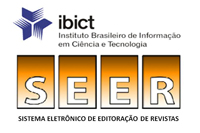CONCORDÂNCIA ENTRE EXAME GINECOLÓGICO E ACHADOS ULTRASSONOGRÁFICOS E ANATOMOPATOLÓGICOS DE MULHERES SUBMETIDAS À TRATAMENTO CIRÚRGICO POR LEIOMIOMATOSE UTERINA EM HOSPITAL UNIVERSITÁRIO
Resumo
OBJETIVO: Avaliar a concordância entre o exame ginecológico bimanual, os achados ultrassonográficos e anatomopatológicos. MÉTODOS: Estudo retrospectivo de 201 prontuários de mulheres submetidas à tratamento cirúrgico por leiomiomatose uterina no Hospital Universitário do Piauí, entre novembro de 2013 e maio de 2016. O volume uterino foi mensurado através dos exames bimanual, ultrassonográfico e histopatológico, assim como a localização, a quantidade e o tamanho desses tumores. Foram realizados os Teste de Wilcoxon e de Friedman para verificação de diferenças entre as distribuições das mensurações, ao nível de significância de 5%. RESULTADOS: Foi verificada diferença estatisticamente significativa entre as distribuições de volumes uterinos, comparando-se os volumes uterinos identificados por toque bimanual, ultrassonografia e exame anatomopatológico (p<0,001). Verificou-se diferença estatisticamente significativa entre as localizações/quantidade, de modo que a maioria dos resultados discordantes por exame anatomopatológicos foram maiores em comparação aos ultrassonográficos 32 (15,9%) (p<0,001). As medidas do tamanho dos miomas foram concordantes (p=0,739). CONCLUSÕES: Houve baixa concordância entre os volumes uterinos estimados pelo toque bimanual, ultrassom e histopatológico. Comparando-se os resultados ultrassonográficos ao toque ginecológico apenas, houve concordância de 51,8%. Nas mensurações de volume uterino por anatomopatológico, a maioria da população avaliada apresentou valores maiores em relação ao toque bimanual e concordantes comparando com o ultrassom. A histerectomia foi o procedimento cirúrgico mais prevalente.
Palavras-chave
Texto completo:
PDFReferências
Berek JS. Berek & Novak: Tratado de ginecologia. 15 ed. Rio de Janeiro: Guanabara Koogan;2014.
Bozzini N, et al. FEBRASGO – Manual de Orientações em Leiomioma Uterino. [Internet]. São Paulo, 2004. Disponível em: http://www.itarget.com.br/newclients/sggo.com.br/2008/extra/download/LEIOMIOMA-UTERINO
Commandeur AE, Styer AK, Teixeira JM. Epidemiological and genetic clues for molecular mechanisms involved in uterine leiomyoma development and growth. Hum. reprod. [Internet]. 2015; 21(5): 593-615. Disponível em: https://www.ncbi.nlm.nih.gov/pmc/articles/PMC4533663/
Faria J, Godinho C, Rodrigues M. Uterine fibroids a review. Acta Obstet. Ginecol. Port. [Internet]. 2008; 2(3):131-142. Disponível em: http://www.fspog.com/fotos/editor2/1_ficheiro_296.pdf
Parker, W. H. Etiology, symptomatology and diagnosis of uterine myomas. Fertil Steril. [Internet]. 2007; 87: 725-736. Disponível em: http://www.sciencedirect.com/science/article/pii/S001502820700221X
Speroff, L., Fritz, M. A. Endocrinologia Ginecológica Clínica e Infertilidade. 8 ed. São Paulo: Revinter; 2014.
Cantuaria GH, Angioli R, Frost L, Duncan R, Penalver MA. Comparison of bimanual examination with ultrasound examination before hysterectomy for uterine leiomyoma. Obstet. Gynecol. [Internet]. 1998 [acesso em 2016 Maio 20]; 92: 109-112. Disponível em: https://www.ncbi.nlm.nih.gov/pubmed/9649104
Stewart EA, Elizabeth A. Uterine Fibroids. N Engl J Med. [Internet]. 2015 [acesso em 2016 Dez 09]; 372: 1646-1655. Disponível em: https://www.ncbi.nlm.nih.gov/pubmed/25901428
Stoelinga B, Huirne J, Heymans MW, Reekers JA, Ankum WM, Hehenkamp WJK. The estimated volume of the fibroid uterus: a comparison of ultrasound and bimanual examination versus volume at MRI or hysterectomy. Eur. j. obstet. gynecol. reprod. biol. [Internet]. 2015 [acesso em 2016 Jun 02]; 184: 89-96. Disponível em: http://www.sciencedirect.com/science/article/pii/S0301211514005946
Owen C, Armstrong, AY. Clinical Management of Leiomyoma. Obstet. gynecol. clin. North Am. [Internet]. 2015; 42: 67-85. Disponível em: http://www.sciencedirect.com/science/article/pii/S0889854514000813
Zivković N, Zivković K, Despot A, Paić J, Zelić A. Measuring the volume of uterine fibroids using 2- and 3-dimensional ultrasound and comparison with histopathology. ActaClin Croat. [Internet]. 2012; 51: 579-589. file:///C:/Users/marcelo.andrade/Downloads/06_Zivkovic.pdf
Boosz AS, Reimer P, Matzko M, Römer T, Müller, A. The Conservative and Interventional Treatment of Fibroids. Dtsch. Arztebl. Int. [Internet]. 2014 [acesso em 2016 Jun 02]; 111: 877–83. Disponível em: http://www.aerzteblatt.de/pdf/DI/111/51/m877.pdf
Harb TS, Adam RA. Predicting uterine weight before hysterectomy: ultrasound measurements versus clinical assessment. Am. j. obstet. gynecol. [Internet]. 2015 [acesso em 2016 maio 20]; 193: 2122–2125.Disponível em: http://www.sciencedirect.com/science/article/pii/S0002937805010835
Surendran, S. Uterine volume: na aid to determine the route and technique of histerectomy. [dissertação] [Internet]. Bangalore: Rajiv Gandhi Universityof Health Sciences; 2011. [acessoem 2016 Maio 16]. Disponível em: http://www.slideshare.net/mail2sbpatil/uterine-volume-an-aid-to-determine-the-route-and-technique-44127258.
Dekel A, Farhi J, Levy T, Orvieto R, Shalev Y, Dicker D. Pre-operative ultrasonographic evaluation of nongravid, enlarged uteri - correlation with bimanual examination. Eur. j. obstet. gynecol. reprod. biol. [Internet]. 1998; 80: 205-207. Disponível em: http://www.sciencedirect.com/science/article/pii/S0301211598001183
Baird DD, Saldana TM, Shore DL, Hill MC, Schectman JM .A single baseline ultrasound assessment of fibroid presence and size is strongly predictive of future uterine procedure: 8-year follow-up of randomly sampled premenopausal women aged 35–49 years. Hum. reprod. [Internet]. 2015; 30(12): 2936–2944.Disponível em: https://www.ncbi.nlm.nih.gov/pmc/articles/PMC4643527/
DOI: https://doi.org/10.26694/2595-0290.113-16
Apontamentos
- Não há apontamentos.
Indexado em:
Diretórios:







